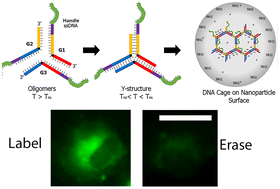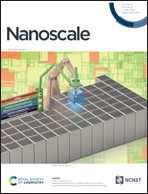DNA-caged nanoparticles via electrostatic self-assembly†
Abstract
DNA-modified nanoparticles enable DNA sensing and therapeutics in nanomedicine and are also crucial for nanoparticle self-assembly with DNA-based materials. However, methods to conjugate DNA to nanoparticle surfaces are limited, inefficient, and lack control. Inspired by DNA tile nanotechnology, we demonstrate a new approach to nanoparticle modification based on electrostatic attraction between negatively charged DNA tiles and positively charged nanoparticles. This approach does not disrupt nanoparticle surfaces and leverages the programmability of DNA nanotechnology to control DNA presentation. We demonstrated this approach using a vareity of nanoparticles, including polymeric micelles, polystyrene beads, gold nanoparticles, and superparamagnetic iron oxide nanoparticles with sizes ranging from 5–20 nm in diameter. DNA cage formation was confirmed through transmission electron microscopy (TEM), neutralization of zeta potential, and a series of fluorescence experiments. DNA cages present “handle” sequences that can be used for reversible target attachment or self-assembly. Handle functionality was verified in solution, at the solid–liquid interface, and inside fixed cells, corresponding to applications in biosensing, DNA microarrays, and erasable immunocytochemistry. These experiments demonstrate the versatility of the electrostatic DNA caging approach and provide a new pathway to nanoparticle modification with DNA that will empower further applications of these materials in medicine and materials science.

- This article is part of the themed collections: Emerging concepts in nucleic acids: structures, functions and applications and U.S National Nanotechnology Day 2023


 Please wait while we load your content...
Please wait while we load your content...